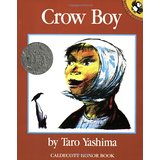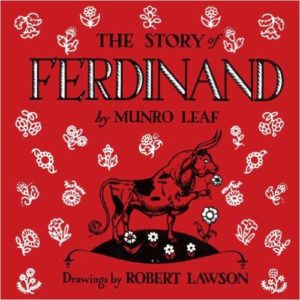I can’t leave the topic of favorite books for young children without mentioning two oldies carrying a timeless message.
As long as there are children, there will be those who struggle to belong. In my day we called it peer pressure to conform and those not fitting a certain mold were rejected. Today we hear a lot about bullying. The problem remains the same: those who are different have a hard time finding acceptance.
Two classic children’s books speak to the issue of unique personalities and how absolutely okay it is to be different.
Crow Boy by Taro Yashima is such a story.
Written in 1955 this hauntingly beautiful story is set in a mountain village in Japan. On the first day of school the little boy is so afraid that he hides underneath the building. He is brought inside, and named Chibi, which means tiny boy. Chibi has no friends and pays no attention in class. He arrives every day with the same lunch—a rice ball in a radish leaf. He suffers isolation and rejection for five long years.
But in his sixth year of school there is a new teacher. Mr. Isobe speaks to Chibi during recess breaks and puts his drawings on the school wall. He calls on Chibi for answers to questions and listens to his responses. When it’s time for the talent show at the end of the year, Mr. Isobe convinces Chibi to enter and share his ability to imitate the sounds of the crow. Chibi knows the difference between the sounds of newborn crows and old ones. He can make their happy and sad sounds and can mimic them when they’re scolding.
In addition to receiving accolades for his talent, Chibi is given an award for perfect attendance all six years of school. He has walked each day, leaving his home at dawn and returning home at sunset. He is given a new name, Crow Boy, and he’s finally accepted just as he is.
Interestingly, the author wrote this book under a pseudonym as he had fled Japan at the beginning of WWII, to join the American army. He had protested his own government’s militaristic regime and feared reprisals at home if his identity became known.
With an entirely different tone, but a similar message:
Ferdinand by Munro Leaf and illustrated by Robert Lawson
Every young bull dreams of being rough and tough enough to be selected to fight in the bullfights in Madrid. But Ferdinand prefers to sit under a cork tree and smell the flowers. Then one day while five men are selecting the next bulls for the fights, poor Ferdinand is stung by a bee. Our quiet and gentle bull is seen as a fearsome warrior and hauled off to fight.
True to himself, when sent into the bull ring Ferdinand chooses to rest and smell the flowers gracing the hair of the women in the stadium. Though it is deemed a great tragedy, the men must allow Ferdinand to leave the bull ring without engaging in one pass.
This book was written in 1936 and has been a best-seller ever since. Munro Leaf died in 1976, but his peace-loving little bull, Ferdinand, lives on in the hearts of his readers.





 The Exploits of Edna and Gertie Join the fun, get your copy now!
The Exploits of Edna and Gertie Join the fun, get your copy now!
I loved Ferdinand but never heard of/saw “Crow Boy.” I’ll have to look for it in the library.